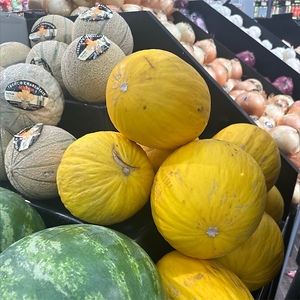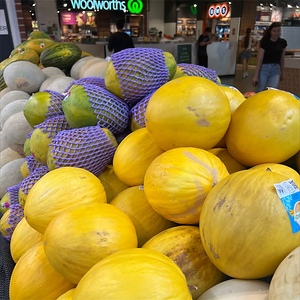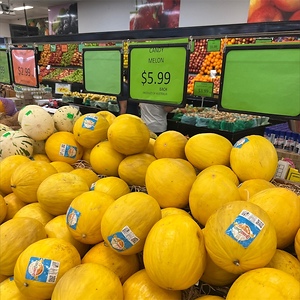


Orange Candy Melons
Estimated Inventory, lb : 0
Description/Taste
Orange Candy melons are a compact varietal, averaging around 14 centimeters in diameter and 19 centimeters in length, and have a uniform, round to oval shape with blunt, curved ends. The melons are typically harvested when they have reached 1.2 to 1.8 kilograms in weight, sometimes reaching up to 2.5 kilograms, and the rind ripens from green to a dull white, followed by a vibrant yellow hue when ripe, visually indicating when it is ready to be picked. The rind is also semi-thin, hard, smooth, and taut, covered in shallow striations and ridges, giving the surface a lightly textured feel. Underneath the surface, the thick flesh ranges in color from pale to bright orange and is firm, aqueous, and dense with a crisp, crunchy consistency. Orange Candy melons are firmer than other varieties and are often described as having a texture similar to nashi pears. The flesh also encases a central hollow cavity filled with stringy fibers and tear-drop-shaped tan to cream-colored seeds. Orange Candy melons release a floral and fruity scent when ripe and should feel heavy for their size, indicating ample juice within the flesh. If shaken, ripe melons will also have a light rattling noise from seeds moving in the cavity. Orange Candy melons are consumed ripe and have a high Brix content, reaching around 17.3 degrees. This high sugar content creates a sweet, candy-like flavor combined with refreshing, tropical, and tangy nuances to evoke a balanced, bright taste.
Seasons/Availability
Orange Candy melons are grown in the Southern and Northern Hemisphere, providing year-round availability in some markets.
Current Facts
Orange Candy melons, botanically classified as Cucumis melo, are a modern, sweet variety belonging to the Cucurbitaceae family. The brightly colored melons are a type of Amarillo melon, also known as Canary or Spanish melon, and were developed in Spain for commercial release in the 21st century. Orange Candy melons are named for their flesh coloring and flavor, and the melons are a productive variety grown on trailing vines. The fruits are ready for harvest approximately 60 to 70 days after planting and offer resistance to fusarium and powdery mildew. Orange Candy melons are sometimes generally referred to as Candy melons in markets and are valued by consumers for their fragrant, crisp, and juicy nature. Since their commercial release, Orange Candy melons have expanded to worldwide cultivation, and the variety is being grown as a premium, fresh-eating fruit. Orange Candy melons can be utilized raw or cooked in a wide array of sweet or savory culinary preparations.
Nutritional Value
Orange Candy melons have not been extensively studied for their nutritional properties. Like other types of Amarillo or Canary melons, the variety may be a source of fiber to regulate the digestive tract, vitamin C to strengthen the immune system, and vitamin A to maintain healthy organs. Melons also provide potassium to balance fluid levels within the body, manganese to produce connective tissues, iron to develop the protein hemoglobin for oxygen transport through the bloodstream, calcium to protect bones and teeth, and phosphorus to assist in making RNA and DNA.
Applications
Orange Candy melons have a sweet, tangy, and tropical taste suited for fresh and cooked preparations. The variety is primarily eaten straight out of hand, discarding the rind and seeds. The melons should be washed before opening, and once cleaned, they can be easily sliced into wedges and eaten as a snack. Orange Candy melons are also popularly chilled before serving to enhance the overall flavoring. The melons can be cut and tossed into green salads, mixed with pickled onions, herbs, or other vegetables as a fresh side dish, or placed on simple fruit plates with prosciutto. Orange Candy melons are also used as a topping over oatmeal, cottage cheese, and parfaits or consumed as a side to breakfast and lunch dishes. While less common, Orange Candy melons can be layered into sandwiches for added crunch or be finely chopped and topped over crostini. In addition to fresh preparations, Orange Candy melons can be blended and frozen into popsicles, sorbet, and granitas. They are also used as flavoring in tarts, tea loaves, custard, cakes, and gelatins. Try incorporating pieces of the flesh into a sweet filling for dessert buns or simmering them into jams, jellies, syrups, and other preserves. The melons can also be grilled and served with a dairy-based topping, like honey and yogurt. Beyond culinary dishes, Orange Candy melons are used in drinks, including smoothies, cocktails, shakes, coolers, and fruit juices. Orange Candy melons pair well with nuts such as pistachios, almonds, and pine, cheeses including Haloumi, feta, goat, and mozzarella, herbs such as mint, cilantro, and basil, coconut milk, cinnamon, raspberries, figs, avocado, and arugula. Whole, unopened Orange Candy melons should be ripened at room temperature in a cool, dry, and dark location away from direct sunlight. Once ripe, the melons should be immediately consumed for the best quality and flavor. Sliced melons are kept in a sealed container in the refrigerator’s crisper drawer for a few days.
Ethnic/Cultural Info
Orange Candy melons are promoted for their thin, semi-smooth rinds. These rinds are said to be slightly more hygienic than netted varieties, as the melon’s netting can house bacteria that can cause salmonella and listeria outbreaks. Regardless of the melon variety, the rind should still be washed with soap before slicing, as the process of slicing can pull bacteria into direct contact with the flesh that is eaten. Orange Candy melons were also chosen for commercial release as the variety is easy to grow as the fruits crack less in the fields, leading to lower product loss. The melons also change color when they are ready to be picked, making the harvest process simpler and faster. These improved cultivation characteristics have contributed to the variety’s success worldwide and have created a commercial product beneficial for growers and consumers.
Geography/History
Orange Candy melons are native to Europe and were developed in Spain. The variety was created by Seminis, an international seed developer, and was evaluated and tested through the Seminis Iberica Melon Breeding Program in Murcia, Spain. Seminis is currently one of two seed companies under the Vegetables by Bayer brand, an agricultural sector of the Bayer life science company. Bayer operates internationally in over 80 countries and focuses on agriculture, health care, and life sciences. Much of the history of Orange Candy melons is unknown, but the variety was said to have been extensively trialed throughout Murcia, Almeria, and La Mancha in Spain before it was released. Orange Candy melons were officially promoted to European retailers, growers, and traders in 2015. The variety was later introduced to Australian growers in 2017 and eventually was offered to select growers worldwide for year-round cultivation. In Australia, Rapisarda Farms was the first grower of Orange Candy melons for several years, and in 2023, Capogreco Farms was chosen as the new exclusive partner. Outside of Australia, Orange Candy melons are grown in Mexico, and there are cultivation locations in Southern and Northern Mexico for a steady supply of melons to export to countries such as the United States. Orange Candy melons can also be found in regions of Central and South America and are grown in Spain for sale throughout Europe and Asia. Today, Orange Candy melons are sold through select grocers, retailers, and distributors worldwide.
Recipe Ideas
Recipes that include Orange Candy Melons. One










